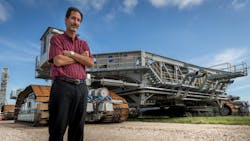How NASA keeps the 'ultimate heavy equipment' running after 50 years
How has NASA kept a vehicle 80 times larger than a fully-loaded tractor-trailer running since the Johnson administration? A stellar maintenance program. And lots of lubrication.
Anyone who works on heavy equipment knows the importance of a good preventive maintenance schedule. There are few heavier pieces of equipment in the world than NASA’s two crawler-transporters, which first hauled Saturn V rockets to a Kennedy Space Center launchpad during the Apollo era of spaceflight.
This spring, 55 years after transporting its first rocket, NASA will use a strengthened Crawler-Transporter 2 to move its most enormous load yet: the 380-ft. Mobile Launcher 1 with the Space Launch System (SLS) atop it. That SLS is a mighty rocket-launch tower that weighs 11.3 million lb. This could be one of the most critical last-mile deliveries this century.
This April or May, the crawler will roll underneath the mobile launcher constructed inside the Vehicle Assembly Building, pick it up, and slowly carry it and the Orion spacecraft about 4 miles to Launch Pad 39B for the maiden launch of NASA’s Artemis program, which will set the stage for the space program to return to the moon and farther—including Mars.
“Over five decades of doing this, they have a pretty good idea of what needs to be done on a regular basis, year after year,” John Giles, engineering operations manager for development and operations for NASA’s crawler-transporters, told FleetOwner.
The team has a full, monthly maintenance program for the machines.
“It’s really just like anything else—except it’s bigger,” said Sam Dove, Jacobs Engineering Group's senior crawler-transporter engineer, who rattled off a long list of vehicle systems his team regularly checks off the top of his head. “You have to keep it lubricated.”
That’s a lot of regular maintenance and lubrication over 57 years. It can be like caring for a classic car.
“After so many years, some systems need to be rebuilt,” Dove explained. “If you have a ’72 Camaro, some of those parts are going to be a little hard to get, so you might have to upgrade and get something new. So that goes along with the maintenance program.”
The team has a full, monthly maintenance program for the machines. Dove rattled off a long list of vehicle systems his team regularly checks off the top of his head. “It’s really just like anything else—except it’s bigger,” he added. “You have to keep it lubricated.”
That’s a lot of regular maintenance and lubrication over 57 years. It can be like caring for a classic car. “After so many years, some systems need to be rebuilt,” Dove explained. “If you have a ’72 Camaro, some of those parts are going to be a little hard to get, so you might have to upgrade and get something new. So that goes along with the maintenance program.”
For example, Giles said NASA needs to replace the crawler’s steering cylinders after the next rocket launch. “Right now, we’re in the process of having a company build us a full lot of new steering cylinders that are quite specialized. So, it's a very big-ticket item.”
Each crawler has eight tank-tread-like belts with 57 shoes. Each shoe weighs 2,000 lb. and lasts about 1,000 miles. Dove said he could tell the current shoes on the crawler, last replaced in 2004, are nearing their final runs after years of hauling millions of pounds at a time.
“In a tractor-trailer, you get almost instantaneous steering. With the crawler, you have to see where it’s going. You have to steer, wait, and then everything catches up. Then you steer a little more and wait. Plus, there is a limit to how much you can steer at one time. You have to have your speed right, you have to be positioned right, you have to get the steering in at the right time. And that probably takes little patience,” he said with a laugh.
“As Sam said, one of the big reasons that this thing’s still operating after being built in the mid-’60s is lubrication,” Giles said. “Everything that’s moving gets lubricated. And it probably also gets an accelerometer or a strain gauge put on it, too, so it can be monitored.”
The crawler has two 2,500-gallon diesel fuel tanks filled up before any trip. The fuel powers two 16-cylinder Alco engines and two 16-cylinder Cummins Power engines. The crawler’s mpg is more easily measured in fpg: 32 feet per gallon, which equates to about 165 gallons per mile.
Click here to read the full story, a Q&A with NASA engineers, and view a media gallery.
This story originally appeared on FleetOwner.com.About the Author
Josh Fisher
Technology Editor
Editor-in-Chief Josh Fisher has been with FleetOwner since 2017. He covers everything from modern fleet management to operational efficiency, artificial intelligence, autonomous trucking, alternative fuels and powertrains, regulations, and emerging transportation technology. Based in Maryland, he writes the Lane Shift Ahead column about the changing North American transportation landscape.


